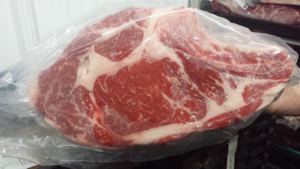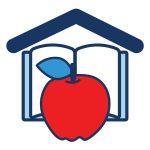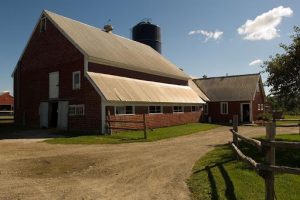2020-2021 Statewide Highlights
Maine Food System
Selling Meat in Maine
Relevance — Livestock producers in Maine have found many ways to sell their animals for farm income including the live animal market channels, such
as auctions, as well as wholesale and retail market channels, such as carcass sales or cuts of meat direct to restaurants or consumers. As livestock farmers get more and more animals, their attention to marketing becomes more diversified and they look to places that give a higher return. Many look to meat sales direct to consumers to try to increase their market options. Meat sales require a higher level of involvement from the Maine Department of Agriculture, Conservation, and Forestry (MDACF) as these animals need to go through a state or federal inspected facility to be sold in commerce. The farm’s label doesn’t need to be attached if they use the slaughterhouse “house” label and have the licenses to distribute.
Response — The details of this market method may seem daunting, but the University of Maine Cooperative Extension (UMaine Extension) and the MDACF sponsored two sessions on “Selling Meat in Maine” for red meat producers and for poultry producers by Zoom, live-streamed to Facebook and recorded sessions for those unable to attend the live sessions in the spring of 2021. Speakers were from UMaine Extension, MDACF, and farmers who produce and processor livestock.
 Results — Using traditional and social media to promote the sessions, 101 people signed up for the program or program materials that were sent afterward. 67 attended one or both sessions live. Another 208 were reached through the Facebook live-streaming of the program. When registering people were asked if they raised livestock (75% yes) and what type of livestock they raised. And they indicated 47% chickens, 33% beef, 23% swine, 18% sheep, 14% turkeys, and 13% goats.
Results — Using traditional and social media to promote the sessions, 101 people signed up for the program or program materials that were sent afterward. 67 attended one or both sessions live. Another 208 were reached through the Facebook live-streaming of the program. When registering people were asked if they raised livestock (75% yes) and what type of livestock they raised. And they indicated 47% chickens, 33% beef, 23% swine, 18% sheep, 14% turkeys, and 13% goats.
In a post-program evaluation, participants estimated and an average of $94.50 per animal increase in income as a result of these sessions. The average number of animals for these respondents was 29, so an estimated increase in income per person who attended the sessions was $2,693. The staff with the MDACF reported that they had one new 1,000 exemption and custom exempt farm, one new licensee, and a home processor, and received 4 other inquiries about livestock processing from program participants.
Victory Gardens for ME
Relevance — In 2020, the pandemic created a significant increase in demand for home food production information, particularly from beginning gardeners, and simultaneously put a stop to UMaine Extension’s ability to provide in-person programming to support that interest.
Response — In response, Extension created a 10-part video series for Mainers growing their first vegetable garden, with episodes including Vegetable Gardening, Planning Your Garden, Preparing Your Garden Soil, Get Planting, Managing Weeds, How to Water Your Garden, What’s Wrong With My Plant?, What to Do With Your Harvest, Pain-Free Gardening, and Preparing Your Garden for Winter. UMaine Extension also created a series of thrice-a-week online “Garden Chats.”
Results — The Victory Garden series has had more than 5,000 views, and over the 10 weeks, they ran the Garden Chats had 1,155 participants.
4-H Positive Youth Development
4-H Volunteers Go Virtual to Help Youth Thrive in the Pandemic
Relevance – As the pandemic progressed there was widespread concern for youth who were experiencing isolation and loss of daily routine and social outlets. 4-H is well-positioned to help families reduce isolation and increase social interaction, and while it could not be done in person, it could be done with virtual platforms programming. “4-H can build intentional programs for youths as we move from reaction to recovery and rebuilding…ensure that young people not only survive but thrive in this time like no other” (Arnold and Rennekemp, 2020). To help youth to thrive, UMaine Extension staff recognized it would be crucial to have confident and capable volunteers on board. However, many 4-H club volunteers were not confident in adapting from in-person to virtual programming.
Response – Extension created a collection of six tip sheets:4-H Volunteers Can Go Virtual! The tip sheets and embedded videos provided tangible ideas to help volunteers navigate how to set up and run virtual meetings. Topics included:

- Tips for Hosting a Virtual 4-H Club Meeting
- Components of a Virtual 4-H Club Meeting
- Ice Breaker Ideas for Virtual 4-H Club Meetings
- 4-Hing at a Distance Activity Ideas
- Virtual Judging Workshop
- Virtual Skill-a-thon
Results – These resources were widely shared through a variety of means, including a website that has received more than 5,206 views from individuals located across 44 states and 16 countries.
Web-based Resources for Families, Caregivers, and Educators
Relevance – The pandemic caused Maine schools to close and left families and children with huge gaps in daily structure and educational experiences.
Response – UMaine Extension responded by creating a web-based resources center for families, caregivers, and educators. We assembled a collection of activity books, guides, and resources with topics ranging from science to financial literacy to help children remain engaged in educational experiences throughout the time period of school closures. The resources were arranged by age range and subject area for easy searchability. We also created and organized a daily schedule of video clips to engage youth and families in additional learning:
● Mondays – Stir Together (nutrition)
● Tuesdays – Teen Science Cafe (science)
● Wednesdays – Wednesday in the Woods (environmental and arts)
● Thursdays – Growing Maine Gardeners (gardening)
● Fridays – 4-H Fridays Fun (fun and creativity)
Results – In just over 6 months our website “Learn at Home: Educational
Resources to Use During School Closures” had more than 11,100 page views, and our educational video clips had over 8,100 views.
Sustainable Community and Economic Development
So You Want to Farm in Maine? On-line 
Relevance – Current farmers thinking about changing farm enterprises and new farmers interested in starting a farm may lack the skill, knowledge and confidence to investigate their options to start, adapt, and maintain a profitable land-based business. Major issues farmers and potential farmers (whether full-time or part-time) need to overcome include access to capital, understanding of rules and regulations affecting agriculture operations, and marketing options.
Response – To enhance the business management knowledge, skills, and confidence of new and established farmers, UMaine Extension developed the “So, You Want to Farm in Maine” (SYWTFIM) series. Since 2015, 292 people have participated through face-to-face, video-linked, webinars, live-streamed, Zoom, and archived sessions to learn about agriculture enterprise selection, business planning, record keeping, market research, regulations, and resource identification. In the spring of 2021, the class was all virtual with 68 people registered.
Results – Knowledge change was assessed by a post-program evaluation. The 47 participants (16%) who completed an evaluation, all reported having moderate to considerable knowledge and understanding of the following topics following the program: Goal Setting and Farm Business Management Plan Development, Marketing and Market Research, and Recordkeeping (Production and Financial).
In 2021, the participants who chose to get the FSA certification included enterprise budgets that totaled $138,009 in projected income. Overall, participants increased their understanding of the 10 major topics presented by 59% for 2021 class. Farm Service Agency provided $2.7 million in farm direct loans as a result of Maine farmers attending this approved borrower training.
Maine Farm and Seafood Products Directory Helps Consumers Find Vendors
Relevance — The onset of the COVID-19 pandemic created widespread fear about what would happen to the markets and businesses of Maine-based farmers. The nearly overnight shutting of restaurants and institutional markets (such as colleges and industrial campuses) and temporary closing of farmer’s markets appeared to directly shut off farmers from the majority of their markets. This impacted farms and food-based businesses of all types and scales, including vegetables, meat, dairy, cut flower, seafood, and bakeries.
Response — In March 2020, an innovative farmer reached out to UMaine Extension for support in promoting a simple spreadsheet that she’d created for seven neighboring farms including their contact information, products available, immediate needs on the farm, and COVID-19 protocols that they had incorporated into their marketing strategies. Extension used our statewide networks and staff to expand on this idea, developing a process for farmers throughout the state to join the list, creating a website to promote the effort, and creating a public-facing map and spreadsheet for viewing the farm information. The farm community saw the value of this marketing tool for connecting with direct-to-consumer sales and quickly signed up.
spreadsheet that she’d created for seven neighboring farms including their contact information, products available, immediate needs on the farm, and COVID-19 protocols that they had incorporated into their marketing strategies. Extension used our statewide networks and staff to expand on this idea, developing a process for farmers throughout the state to join the list, creating a website to promote the effort, and creating a public-facing map and spreadsheet for viewing the farm information. The farm community saw the value of this marketing tool for connecting with direct-to-consumer sales and quickly signed up.
Results — Within a month there were 405 farm and seafood vendors listed and more than 100,000 views to the page, and there are now nearly 500 (13 from Piscataquis County). While the community demand for local food and direct-to-consumer sales have significantly increased as a result of the pandemic, farmers have attributed much of their new customer base this year to the popularity of this list. The directory has also assisted farms in finding complementary partner farm business with which to build collaborative marketing systems. This transition of markets also includes farms that were primarily wholesale farms transitioning to marketing through established direct-to-consumer farms.
